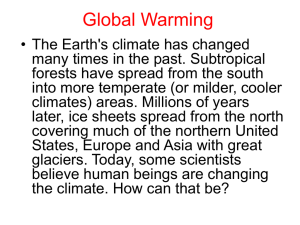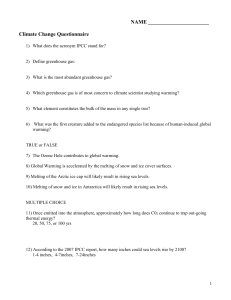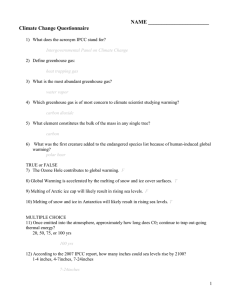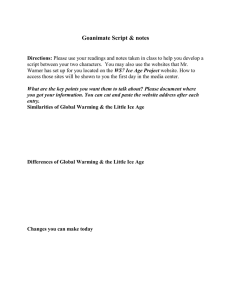8.6 Global Warming
advertisement
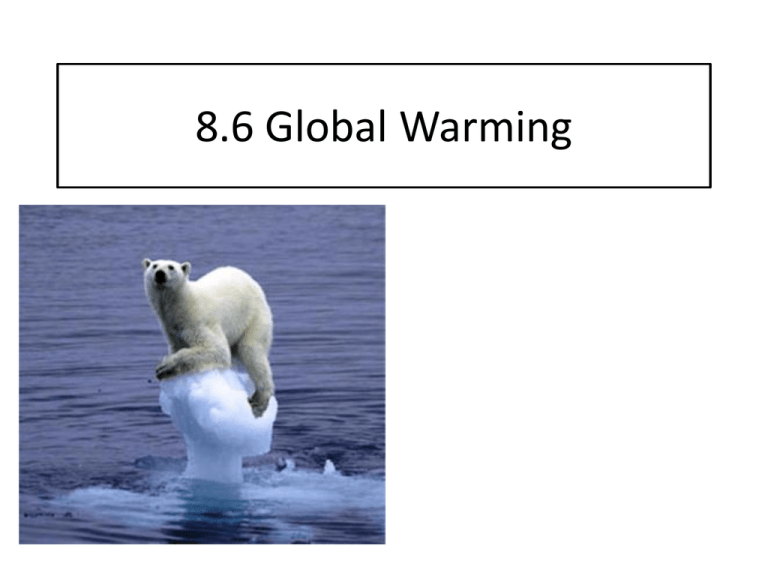
8.6 Global Warming Greenhouse Effect Simulation • http://phet.colorado.edu/en/simulation/gree nhouse • http://phet.colorado.edu/en/simulation/glaci ers • http://phet.colorado.edu/en/simulation/black body-spectrum What do you know? What questions do you have? What biases do we need to be aware of? 8.6 Global Warming benchmarks 8.54 Describe some possible models of global warming 8.55 State what is meant by the enhanced greenhouse effect 8.56 Identify the increased combustion of fossil fuels as the likely major cause of the enhanced greenhouse effect 8.57 Describe the evidence that links global warming to increased levels of greenhouse gases 8.58 Outline some of the mechanisms that may increase the rate of global warming 8.59 Define coefficient of volume expansion 8.60 State that one possible effect of the enhanced greenhouse effect is a rise in mean sea-level 8.61 Outline possible reasons for a predicted rise in mean sea-level 8.62 Identify climate change as an outcome of the enhanced greenhouse effect 8.63 Solve problems related to the enhanced greenhouse effect 8.64 Identify some possible solutions to reduce the enhanced greenhouse effect 8.65 Discuss international efforts to reduce the enhanced greenhouse effect 8.6 – Global Warming • Essential Questions – What is the mainstream assumption about Global warming? – What are the different opinions regarding global warming? – What efforts are underway to research and reduce climate change? • Enduring Understandings – Carbon Dioxide levels have risen – Global Warming is controversial – Informed opinions are more powerful than ignorant ones Global warming • The next figure shows the variation of the deviations of the earth’s average T from the expected long-term average since 1880. Global warming Global warming – concentration of CO2 • CO2 concentration has doubled since the nineteenth century (pre-industrial times). • There seems to be a connection between global warming and greenhouse gases but some say that the data collected does not cover a large enough time span. Global warming – concentration of CO2 • However, analysing samples from ice cores in Antarctica and Greenland it is possible to measure the concentration of different gases at the time of freezing. • The results show that there is a very close link between global warming and increased greenhouse gas concentrations. • Some of the Antarctic ice cores are extracted form a depth of about 3600m over the frozen lake Vostok. • They reveal a connection between temperature changes and changes in CO2 and CH4 concentrations. Global warming – concentration of CO2 • The ice cores give a detailed account of global climate conditions over a time period spanning some 420 000 years. The figure below shows how T and [CO2] have varied over time. Global warming – concentration of CO2 • The figure below shows that the earth was warmest whenever the levels of CO2 in the atmosphere increased. • Looking at the present concentration of CO2 it is certain that temperature will increase. • What is uncertain is the detailed effect of this temperature increase on the global climate – in magnitude and in time scale. Global warming Global warming Global warming • The majority of experts tend to agree that the enhanced greenhouse effect is behind global warming. • But some say that GW may be due to an increase solar power output as solar activity has a periodic variation. • However, the pattern of GW is not consistent with this variation. • Other theories include the increase of volcanic activity, variations of eccentricity of the earth’s orbit around the sun as well as ‘tilt’ of the orbit with respect to the sun. • These orbital phenomena occur over time scales ranging from 20 000 to 100 000 years which means that they are not so relevant when only the last 200 years are considered. Sea level • The level of water is always varying due to changes in atmospheric pressure, plate tectonic movements, wins, tides, flow of large rivers into the sea, changes in water salinity and others. • But the problem is when sea level changes because of climate changes. It is know that climate changes affect sea level through the fact that the temperature determines how much ice melts or how much water freezes. • During the last ice age (about 18 000 years ago), the sea level was about 100m lower than it is today. Changes in sea level affect the amount of water that can evaporate and the amount of thermal energy that can be exchanged with the atmosphere. In addition, changes in sea level affect ocean currents which are vital in transferring thermal energy from the warm tropics to colder regions The melting of ice • To melt a mass m of ice requires an amount of thermal energy Q=mLf. • When it comes to discuss sea level, we must distinguish between land ice (ice supported on land) and sea ice (ice floating in sea water). • When sea ice melts, there is no change in sea level. This is a consequence of Archimedes’ principle – the weight of the ice equals to the weight of the displaced water. So when ice melts, the resulting water will occupy the place of ice and no change will take place. • However, when land ice melts, the water will eventually flow to the sea and will increase the sea level. Estimating changes in sea level • Another important aspect of the melting of land ice is that it will expose the dark land underneath the ice. The dark land absorbs light very easily and will radiate IR radiation that will contribute to the increase of global temperature. • Sea level will increase because - more land ice will melt; - warmer water occupies a larger volume. • However, water expansion is anomalous. Water: - contracts in volume when it goes from 0ºC to 4ºC - expands as the temperature is increased further from 4ºC. • This means that the density of water is highest at T=4ºC and this fact has a great importance for life in lakes, rivers and oceans. • Given a volume V0 at a temperature 0, the volume after a temperature increase of will increase by V given by Estimating changes in sea level • Given a volume V0 at a temperature 0, the volume after a temperature increase of will increase by V given by V = V0 where is a coefficient known as coefficient of volume expansion • The coefficient of volume expansion is defined as the fractional change in volume per unit temperature change. • For water, the coefficient actually depends on temperature, and so a given volume of water will change by different amounts even for the same temperature changes depending on the initial temperature of water. Example The area of the earth’s oceans is about 3.6 x 108 km2 and the average depth is 3.7 km. Using γ = 2 x 10-4 K-1, estimate the rise in sea level for a temperature increase of 2K. Comment on your answer. Example The area of the earth’s oceans is about 3.6 x 108 km2 and the average depth is 3.7 km. Using γ = 2 x 10-4 K-1, estimate the rise in sea level for a temperature increase of 2K. Comment on your answer. Volume of water = approx depth x area = 3.6 x 108 x 3.7 = 1.33 x 109 km3 = 1.33 x 1018 m3 ΔV = γV0Δθ ΔV = 2 x 10-4 x 1.33 x 1018 x 2 = 5.3 x 1014 m3 Δh = ΔV/A = 5.3 x 1014/3.6 x 1014 = 1.5 m Evaporation? Greater area cos of flooding? Uniform expansion? What else might happen? • More extreme weather (heatwaves, droughts, hurricanes, torrential rain) What might happen? • Long term climate change What might happen? • Associated social problems (??) Evidence? • • • • Ice core research Weather records Remote sensing by satellites Measurement! Effects of global warming on climate • A higher average earth temperature implies a rising sea level. • One effect on climate of a rising sea level is the change in the albedo of the surface (more water as opposed to dry land). • The change in the albedo will not change significantly the temperature. • However, warmer water at higher temperature evaporates more easily and more water vapour will be released to the atmosphere. • This means: - cooling of the earth’s surface, - more cloud cover (and more reflected radiation) - more precipitation (rain may not fall in the region of interest) Effects of global warming on climate • Another effect of higher T is that the solubility of CO2 in the oceans decreases. This means more CO2 is left in the atmosphere. • Deforestation is a controversial issue. • Rain forests produce CH4 and thus contribute to increased concentrations of greenhouse gases • They absorb CO2 from the atmosphere during photosynthesis but return that CO2 when they die and decompose. Measures to reduce global warming • Using fuel-efficient cars and developing hybrid cars further; • Increasing the efficiency of coal-burning power plants; • Replacing coal-burning power plants with natural gas-fired plants; • Considering methods of capturing and storing the CO2 produced in power plants; • Increasing the amounts of power produced by wind and solar generators; • Considering nuclear power; • Being energy conscientious, with buildings, appliances, transportation, industrial processes and entertainment; • Stopping deforestation. The Kyoto protocol and the IPCC • An extremely important agreement towards cutting greenhouse gas emissions was reached in 1997, in Kyoto, Japan. • The industrial nations agreed to reduce their emissions of GG by 5.2% from 1990 levels between 2008 and 2012. • The protocol allowed mechanisms for developed nations to use projects aimed at reducing emissions in developing nations as part of their own reduction targets. • Endorsed by 160 countries, the protocol would become legally binding if at least 33 countries signed it. • The non-ratification by the USA and Australia has weakened the impact of the agreement. The Kyoto protocol Participation in the Kyoto Protocol Signed and ratified Signed, ratification pending Signed, ratification declined Non-signatory The Kyoto protocol and the IPCC • Unlike Kyoto protocol, which imposed mandatory limits for GG emissions, the Asia-Pacific Partnership on Clean Development and Climate asked for voluntary reductions of these emissions. • It was signed by the USA, Australia, India, China, Japan and South Korea in 2005. • It is an agreement in which the signatory nations agree to cooperate in reducing emissions. • It has been criticized as worthless because the reductions are voluntary but defended because it includes China and India, major GG producers, who are not bond by the Kyoto protocol. The Kyoto protocol and the IPCC • A major, comprehensive, detailed and scientifically impartial analysis of global climate has been undertaken by IPCC. • The IPCC was created by the World Meteorological Organization and the United Nations Environment Programme in 1988. • It does no research of its own but it collects information from scientific material to report on technical and socioeconomic aspects of climate change. • Its 4 reports (1990, 1997, 2001 and 2007) have been instrumental in providing an accurate analysis of the global situation.

